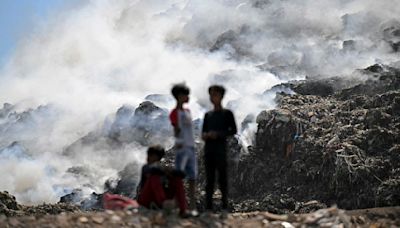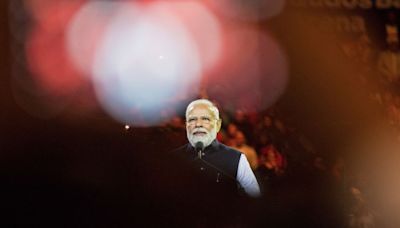Search results
New Delhi is the largest commercial city in northern India. It has an estimated net State Domestic Product (FY 2010) of ₹1,595 billion (US$20 billion) in nominal terms and ~ ₹6,800 billion (US$85 billion) in PPP terms. [96] As of 2013, the per capita income of Delhi was Rs. 230000, second highest in India after Goa.
- New Delhi District
Districts of Delhi. The New Delhi district is an...
- New Delhi Railway Station
New Delhi railway station (station code: NDLS) is the main...
- Transport in Delhi
DTC AC Buses. Delhi has significant reliance on its...
- Sansad Bhavan
The Parliament House ( IAST: Saṁsad Bhavan) in New Delhi is...
- Secretariat Building
The 1931 series celebrated the inauguration of New Delhi as...
- Delhi Durbar of 1911
The Delhi Durbar of 1911, with King George V and Queen Mary...
- New Delhi (Disambiguation)
New Delhi is the capital city of India.. New Delhi may also...
- Indian Capital Cities
العربية; অসমীয়া; বাংলা; Башҡортса; Беларуская (тарашкевіца)...
- New Delhi Municipal Council
New Delhi Municipal Council (NDMC; ISO: Naī Dillī...
- Connaught Place, New Delhi
Connaught Place became the entertainment hub of New Delhi....
- New Delhi District
Delhi, officially the National Capital Territory (NCT) of Delhi, is a city and a union territory of India containing New Delhi, the capital of India.Lying on both sides of the Yamuna river, but chiefly to the west, or beyond its right bank, Delhi shares borders with the state of Uttar Pradesh in the east and with the state of Haryana in the remaining directions.
- 200–250 m (650–820 ft)
- India
New Delhi. New Delhi ( Hindi: नई दिल्ली) is the capital of India. It is also a part of the National Capital Territory of Delhi (NCT). In traditional Indian geography, it is in the North Indian zone. The city has an area of about 42.7 square kilometres (16.5 sq mi). New Delhi has a population of about 9.4 million people.
- Pre Historic Period
- In Mythology
- Medieval Period
- Late Medieval Period
- Mughal Rule
- Maratha Rule
- British Rule
- Post-Independence
- See Also
- Bibliography
There was Ochre Coloured Pottery culture in Red fort area which began around c.2000 BCE according to carbon dating. Around c.1200 BCE the region was inhabited by people of Painted Grey Ware culture which corresponds to Vedic Period. Significant prehistoric sites in Delhi include Anangpur (in the Badarpur region), as well as Harappanexcavations near...
A long-standing tradition associates Delhi with Indraprastha and identifies the legendary city with the village Indarpat, which survived until the early 20th century within the Purana Qila. There is no tangible archeological evidence, however, which links the excavated 'painted greyware' at Purana Qila with the Bharata Khanda site.[need quotation t...
Tomara Rajputs
1. The bastion of Lal Kot fort in Delhi's Mehrauli built by Tomara Rajput ruler, Anangpal Tomarin c. 1052 CE. 2. Sculptures of ancient temple in Qutb Minar complex. 3. Lal Kot, built by Anangpal Tomar II Anangpal Tomar founded Delhi in 1052. A VS 1383 inscription in Delhi Museumconfirms the founding of Delhi by the Tomars. He established the Tomar Dynasty of Delhi in the early 8th century and built his capital at the Anangpur village in Haryana. The Anangpur Dam was built during his reign; th...
Chauhan Rajputs
The Rajput Chahamana (Chauhan) kings of Ajmer conquered Lal Kot in 1180 and renamed it Qila Rai Pithora. The Chauhan king Prithviraj III was defeated in 1192 by Muhammad Ghori in the Second Battle of Tarain, solidifying Muslim presence in northern India and shattering Rajput power in the Indo-Gangetic Plain.
Delhi Sultanate
From 1206, Delhi became the capital of the Delhi Sultanate under the Slave Dynasty. The first Sultan of Delhi, Qutb-ud-din Aybak, was a former slave who rose through the ranks to become a general, a governor and then Sultan of Delhi. Qutb-ud-din started the construction of the Qutub Minar, a recognisable symbol of Delhi, to commemorate his victory but died before its completion. In the Qutb complex he also constructed the Quwwat-al-Islam (might of Islam), which is the earliest extant mosque i...
Timur
In 1398, Timur Lang invaded India on the pretext that the Muslim sultans of Delhi were too tolerant of their Hindu subjects. After defeating the armies of Nasiruddin Mahmud of Tughlaq dynasty, on 15 December 1398, Timur entered Delhi on 18 December 1398, and the city was sacked, destroyed, and left in ruins, and over 100,000 war prisoners were killed as well.
Defeat of the Lodi sultans
In 1526, following the First Battle of Panipat, Zahiruddin Babur, the former ruler of Fergana, defeated the last Afghan Lodi sultan and founded the Mughal dynasty which ruled from Delhi, Agra and Lahore.
The early modern period in Indian history is marked with the rise of the Mughal Empire between the 16th and 18th centuries. After the fall of the Delhi Sultanate, the Mughals ruled from Agra, Sikri and Lahore, but the city once became the capital in 1648 during the rule of Shah Jahan, and remained the capital until the fall of the empire. During th...
Maratha Protectorate
A treaty signed in 1752 made Marathas the protector of the Mughal throne at Delhi. In 1753 Jat ruler Suraj Mal attacked Delhi. He defeated Nawab of Delhi Ghazi-ud-din (second) and captured Delhi in the Capture of Delhi. Jats sacked Delhi from 9 May to 4 June. Ahmad Shah Durrani invaded North India for the fourth time in early 1757. He entered Delhi in January 1757 and kept the Mughal emperor under arrest. In August 1757, the Marathas once again attacked Delhi, decisively defeating Najib-ud-Da...
Decline of the Marathas
In 1803, during the Second Anglo-Maratha War, the forces of British East India Company defeated the Maratha forces in the Battle of Delhi (1803), ending the Maratha rule over the city. As a result, Delhi came under the control of British East India Company, and became a part of the North-Western Provinces. The Mughal Emperor Shah Alam IIremained a mere figurehead.
Revolt of 1857
The Indian Rebellion of 1857 sought to end Company Rule in India. On 11 May, the mutineers reached and captured Delhi, and declared Bahadur Shah Zafar II the Emperor of India, and the Emperor held his first court in many years. However, the British returned and laid siege to Delhi on 8 June 1857. On 21 September, Delhi finally fell into the hands of British troops. The city received significant damage during the battle. Afterwards, the last titular Mughal Emperor Bahadur Shah Zafar II was cap...
British Raj
Calcutta was the capital of British India till 1911 but in 1911 at the Delhi Durbar of 1911, held at the Coronation Park, King George V announced the shifting of the capital to Delhi. New Delhi designed by the British architect Edwin Lutyens was inaugurated in 1931 after its construction was delayed due to World War I. Originally King George V and Queen Mary announced the project, although it did receive major opposition from the European business community of Calcutta, along with Lord Curzon...
During the partition of India, around five lakh Hindu and Sikh refugees, mainly from West Punjab fled to Delhi, while around three lakh Muslim residents of the city migrated to Pakistan. Ethnic Punjabis are believed to account for at least 40% of Delhi's total population and are predominantly Hindi-speaking Punjabi Hindus. Migration to Delhi from t...
Kishore, Raghav (2016). "Planning, traffic and the city: railway development in colonial Delhi, c. 1899–1905". Urban History. 44 (2): 1–17. doi:10.1017/S0963926816000353. S2CID 151717699."History of Delhi District". The Imperial Gazetteer of India, Vol. 11. Oxford at Clarendon Press. 1909. p. 225.Kapoor, Pramod; Singh, Malvika; Mukherjee, Rudrangshu (2009). New Delhi: Making of a Capital. Lustre Press. ISBN 978-81-7436-574-3.Byron, Robert (1931). New Delhi. The Architectural Review, Westminster.Get in [ edit] 28°36′22″N 77°12′0″E. Map of New Delhi. New Delhi is a 20- to 30-minute ride by road from the airport. The trip from the airport station to New Delhi station via Airport Express costs ₹60.00 and takes 23 minutes with trains running every 15 minutes.
Delhi ( English: / ˈdɛli /; Hindustani: [ˈdɪlːi] Dillī; Punjabi: [ˈdɪlːi] Dillī; Urdu: [ˈdeɦli] Dēhlī ), officially the National Capital Territory of Delhi ( NCT ), is a city and territory in India. It includes the country's capital New Delhi. It covers an area of 1,484 square kilometres (573 sq mi). It is bigger than the Faroe ...
People also ask
Is New Delhi a city?
Is New Delhi a capital of India?
Is Delhi a city or a territory?
Which government is located in New Delhi?



